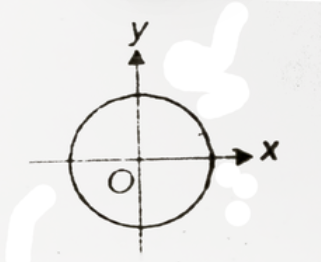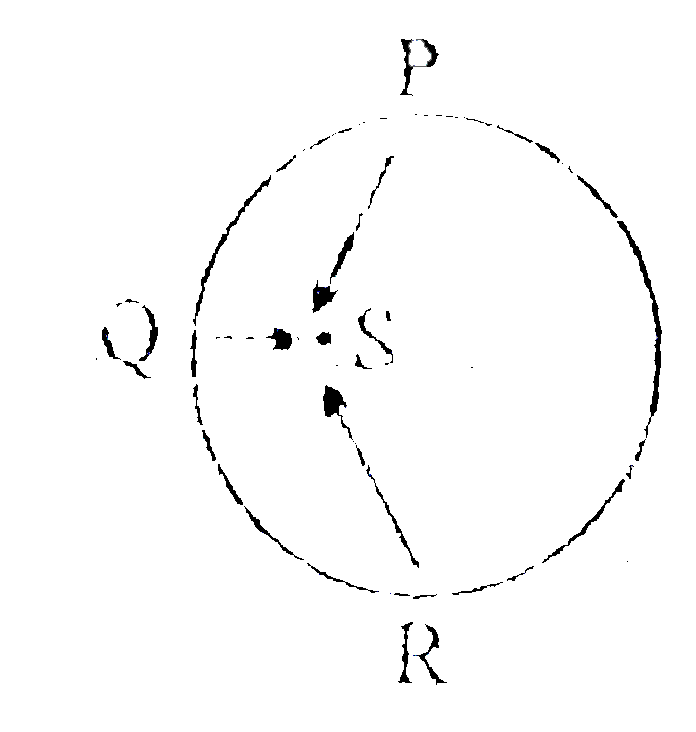An object moves at a constant speed along a circular path in a horizontal plane with centre at the origin. When the object is at x=+2m,its velocity is −4ˆjms.The object's velocity (v) and acceleration (a) at x=−2m will be
v=−4jm/s,a=−8ˆjm/s2
v=4ˆim/s,a=8ˆjm/s2
v=4ˆjm/s,a=8ˆim/s2
v=−4jm/s,a=8im/s2
The correct Answer is:C
To solve the problem, we need to analyze the motion of the object moving in a circular path. Let's break down the steps:
Step 1: Understand the motion
The object is moving in a circular path with a constant speed. This means that while the speed remains constant, the direction of the velocity vector is continuously changing.
Step 2: Identify the given information
- The object is at position x=+2m with a velocity →v=−4^jm/s.
- This indicates that when the object is at x=+2m, it is moving downward (in the negative y-direction).
Step 3: Determine the radius of the circular path
Since the object is moving in a circular path centered at the origin, the radius r can be determined from the position x=+2m. The radius is r=2m.
Step 4: Find the position at x=−2m
When the object is at x=−2m, it will be on the opposite side of the circle. The coordinates at this position will be (−2,0).
Step 5: Determine the velocity at x=−2m
Since the object is moving with constant speed, we need to find the direction of the velocity vector at this position. The velocity vector will be tangential to the circular path.
At x=+2m, the velocity vector is downward, which means the object is moving counterclockwise. Therefore, at x=−2m, the object will be moving to the right (in the positive x-direction).
Thus, the velocity at x=−2m will be:
→v=4^im/s
Step 6: Determine the acceleration at x=−2m
The acceleration of an object moving in a circular path is directed towards the center of the circle (centripetal acceleration). The magnitude of the centripetal acceleration a can be calculated using the formula:
a=v2r
Where v=4m/s and r=2m.
Calculating the centripetal acceleration:
a=(4)22=162=8m/s2
The direction of the acceleration will be towards the center of the circular path, which is at the origin. Therefore, at x=−2m, the acceleration vector will be directed towards the origin, which can be represented as:
→a=−4^im/s2
Final Answer
- Velocity at x=−2m: →v=4^im/s
- Acceleration at x=−2m: →a=−4^im/s2
The object is moving in a circular path with a constant speed. This means that while the speed remains constant, the direction of the velocity vector is continuously changing.
- The object is at position x=+2m with a velocity →v=−4^jm/s.
- This indicates that when the object is at x=+2m, it is moving downward (in the negative y-direction).
Since the object is moving in a circular path centered at the origin, the radius r can be determined from the position x=+2m. The radius is r=2m.
When the object is at x=−2m, it will be on the opposite side of the circle. The coordinates at this position will be (−2,0).
Since the object is moving with constant speed, we need to find the direction of the velocity vector at this position. The velocity vector will be tangential to the circular path.
→v=4^im/s
The acceleration of an object moving in a circular path is directed towards the center of the circle (centripetal acceleration). The magnitude of the centripetal acceleration a can be calculated using the formula:
a=v2r
Where v=4m/s and r=2m.
a=(4)22=162=8m/s2
→a=−4^im/s2
- Velocity at x=−2m: →v=4^im/s
- Acceleration at x=−2m: →a=−4^im/s2
Topper's Solved these Questions
Similar Questions
An object moves at constant speed along a cicular path in a horizontal xy plane. With the centre as origin.when the object is at x= -2m , it s velocity is −4ˆjm/s , its acceleration when it is at y= 2 m/s
 View Solution
View SolutionWhat is the momentum of an object of mass m moving with a velocity v?
View Solution
Knowledge Check
- Question 1 - Select One
An object moves at a constant speed along a circular path in a horizontal XY plane, with the center at the origin. When the object is at x=−2m, its velocity is −(4m/s)ˆj. What is the object's acceleration when it is y=2m
A−(8m/s2)→jB−(8m/s2)→iC−(4m/s2)→jD−(4m/s2)→i - Question 2 - Select One
An object of mass m moves with constant speed in a circular path of radius r under the action of a force of constant magnitude F. the kinetic energy of object is
A12FRBFRC2FRD14FR - Question 3 - Select One
An object moves counter−clockwise along the circular path shown below. As it moves along the path its acceleration vector continuously points towards point S. The object
 Aspeeds up at P,Q and RBshows down at P,Q and RCspeeds up at P and shown down RDshows down at P and speeds up at R
Aspeeds up at P,Q and RBshows down at P,Q and RCspeeds up at P and shown down RDshows down at P and speeds up at R
A particle is moving in xy-plane in circular path with centre at origin.If at an instant the position of particle is given by 1√2(ˆi+ˆj) Then velocity of particle is along
View SolutionThe velocity v of moving object varies with displacement u as v=3x^(2)-2 ,then the acceleration at x=2m is
View SolutionWhat is the momentum of an object of mass m , moving with a velocityv ?
View SolutionWhat is the momentum of an object of mass m , moving with a velocityv ?
View SolutionAn object of mass 5 kg is sliding on a smooth frictionless horizontal surface with a constant velocity of 10 m/s. the force required to keep the object moving with the same velocity is
View Solution

